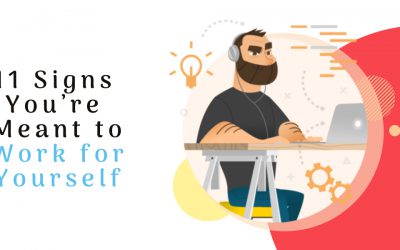Disclosure: This page contains affiliate links, meaning I receive a commission if you decide to make a purchase through our links. This is at no additional cost to you.
There’s a lot of info online about how to become a freelancer. However, it can be really overwhelming to get started. It’s easy to fall into the trap of investing in resources to help you become a freelancer before you ever make a dollar. In this post, I’m going to tell you about 9 things you absolutely need to start freelancing online. The best part? You can get started with all of these things for free. Want to know how to start freelancing now? This post is for you.
The truth about how to start freelancing
When I started freelancing I had absolutely no clue what I was doing. This led me to make a lot of mistakes early on. I also spent a lot of time researching and sometimes often buying things I didn’t need to get started. Now, I’ve been freelancing for 5 years and I know exactly what you need to actually get your first freelance job. In the sections that follow, you’ll discover everything you need to launch your freelance business.
Skills
If you have no idea how to start freelancing and what type of freelance jobs you can do, I have good news for you. There are tons of resources out there to help you learn a craft. You can use free courses to become a successful freelancer. Even if you do know what kind of freelancer you want to be, brushing up on your skills can help. Learning more will give you confidence to get out there and get your first client fast. I highly recommend checking out a few classes. This can help you start your freelance business off on the right foot.
Hubspot has several FREE certifications in sales, marketing, social media and more.
Skillshare has free courses on graphic design, photography, writing and more. (+ thousands of paid courses with Skillshare premium).
Codecademy is a great place to learn coding basics for free.
Can’t find a free course on what you want to do? YouTube is free and full of great tutorials. These can help you learn how to develop the skills you need to be a successful freelancer.
A word of caution: Don’t get too caught up on trying to be perfect at your craft. You’ll learn as you go. Once you know what you want to do and you have a basic understanding of how to do it, get out there and start taking more steps to actually start your freelance business. Otherwise, it’s easy to waste months or even years trying to learn everything. It’s impossible to know everything.
Samples
When you’re confident that you have the skills, now it’s time to start putting some samples together. Don’t overthink this part. You may already have some pieces to show off to clients. For example, if you want to be a freelance photographer, you might already have some awesome photos. Use them. This idea applies to any other type of freelancing too. If you already have work that you’re proud of, use it. Instead of stressing about creating new samples use that time to find yourself a client.
No experience? You don’t have to (and shouldn’t) wait for an opportunity to create samples. If you want to be a freelance social media manager, create some social posts for Instagram or Pinterest. If you want to become a freelance writer, create some writing samples based on who you’d like to write for.
I highly recommend starting with three to five samples. Try to make each one a little bit different so that potential clients can really see the extent of your skills. For example, if you want to be a freelance writer, you might want to create three different pieces with varying lengths. This way clients can see that you can do both short-form and long-form content.
After you get your first paying clients, you can start replacing your samples with some of the work that you’ve gotten paid to do. Having those pieces in your portfolio can be a great talking point with future clients.
Portfolio
Once you have your samples ready, you need a place to show them off to potential clients. There are several options you can choose to put up a portfolio for free. Here are places you can pick from and who they’re best for:
Contently – Ideal for freelance writers
Flickr – For freelance photographers
Behance – For freelance graphic designers
Don’t see your skill here? Don’t worry. The options above work for other types of freelancers too. If you aren’t happy with them, you can always create a portfolio with social media. (More on this below).
Some say that you need your own professional freelance website to start but I disagree. I didn’t create my freelance writer website until I was 3 years into my freelancing career. All you need is a portfolio that looks professional and well organized.
Creating a freelance website is something I recommend doing down the road, but wait until you decide whether or not freelancing is the right path for you before you invest time and money into this.
Photo
Another thing you need to start freelancing online is a photo of you. Before you click off of this post, hear me out. I’m not suggesting that you go and get professional headshots taken with a photographer. What you do need is a nice, professional photo of yourself. It doesn’t have to be perfect and lots of freelancers just use a nice selfie.
However, if you want to take it to the next level there are several tutorials that you can find online to teach you how to take your own headshot using your smartphone. Whatever you choose to do, know that people want to see your face. They want to know that you’re a real person. Having a great photo helps you establish trust with potential freelance clients.
Social media
If you want to become a successful freelancer you should create separate social media profiles for your business. The social network(s) you pick should depend on where your potential clients are hanging out. A great one for all types of freelancers is LinkedIn. You may also find that your potential clients are hanging out on Twitter or Instagram. If you aren’t sure, look up some magazines, brands or businesses that you admire and see where they’re the most active.
Once you have social media set up, be sure to start connecting with people and creating your own posts. Don’t spend hours a day on social media. Instead, start using it to find freelance job opportunities, connect with other freelancers and connect with potential clients too.
Social media can also be a great place to set up your freelance portfolio if you don’t already have one. For example, if you want to be a social media manager, what better way to show that you’re great at what you do than building a great social media profile? If you want to be a freelance graphic designer or a freelance photographer, Instagram is a great place to show off your work.
The point is that using social media well is key. This doesn’t mean you need a million followers or tons of great content before you get your first client. However, establishing yourself on social media can be beneficial to your career as a freelancer.
Professional email address
When you start looking for freelance jobs online you’ll find that a lot of communication happens over email. You want to create a professional email address for two reasons. One, you don’t want your freelance opportunities slipping through the cracks.
Two, it’s best to have a dedicated email address that looks professional. You don’t even have to come up with a business name. You can just use your name. I highly recommend using Gmail. Once you start freelancing, you find that there are tons of helpful extensions that you can add to make tasks much easier. You can also easily transition to G Suite when you’re ready to take your business to the next level.
Bonus tip: Zoho Mail
Zoho Mail is a great option for those of you who are ready to purchase a domain name and set up a website. If you do this, you can get a free email address with your domain using Zoho Mail. I will warn you Zoho Mail is not the most intuitive system and it’s a little clunky. However, if you want to take your email game up a notch, this is for you.
VoIP phone number
This is something I don’t see a lot of people recommending but in my opinion, it’s one of the most important things that you can set up before you start taking on freelance clients. Once you start working, you’ll have to get on calls with clients and you don’t want them having your real phone number.
Take it from me, I’ve dealt with a few crazy clients calling and texting well outside of my business hours. Honestly, when you’re freelancing it can become hard to maintain a work-life balance as it is. When you give clients your personal number, those lines can quickly become even more blurred. Having a VoIP number allows you to keep any business phone calls and texts separate from personal communication.
I personally have a free VoIP phone number through Google Voice. There are other services you can use to achieve the same thing.
Contract
Let me make this clear: do not take a freelance job without having a contract. Ever. These documents are in place to protect you should anything ever go wrong. It also helps you set your client’s expectations before you start working together. Your contract should cover things like the duration of the project, whether or not you have the right to use the work in your portfolio and of course, your rate.
Unfortunately, I’m not a freelance lawyer. So, I’m not going to go into all the details about exactly what should and should not be included in your contract. However, you can find several freelance contract templates online and that’s a good place to start.
Having a contract in place, even if it’s not perfect is better than having no contract in place at all. The way my first contract has changed several times since I started freelancing. You’ll learn what you need to add and change as you gain experience.
Payment processor
Once you put all these things in place and you and your first freelance job (YAY), you need a way to get paid. Some freelancers do get paid via check, but I don’t recommend this. Waiting weeks to get paid is not ideal and it’s unnecessary when you could get your payments from freelance work a lot faster.
I recommend setting up PayPal or Stripe to accept payments. You’ll be charged a small fee for accepting payments through these processors but it’s well worth it. Bonus: PayPal and Stripe also make it easy to invoice your clients. That way, when you’re ready to invoice, you don’t have to go hunting around for a freelance invoice template. You’ll want to create your own, branded invoices eventually, but when you’re first starting out you should focus on getting those invoices sent out and getting paid.
Ready to launch your freelance biz?
If you’re ready to start freelancing, you don’t have to invest hundreds of dollars and spend hours creating samples or a website. You can take these 9 tips and get your business off the ground quickly to find out if freelancing is right for you. Then, you can use the money you make and invest it in tools and resources to help you grow and build an even better business.
Don’t want to forget all these tips on how to start freelancing? Get all the information from this blog post packed into a handy PDF with my freelance business builder checklist.
WANT THE CHECKLIST?
Subscribe to my email list to get the free checklist.
Thank you!
You have successfully joined our subscriber list.




0 Comments